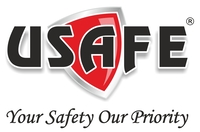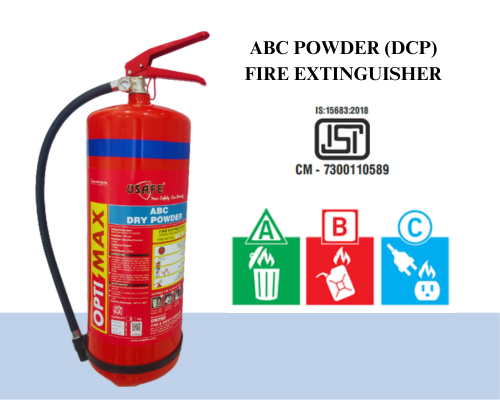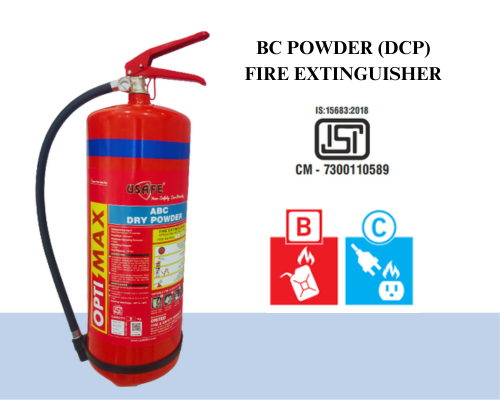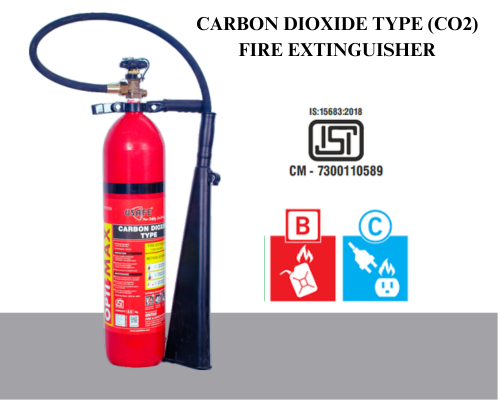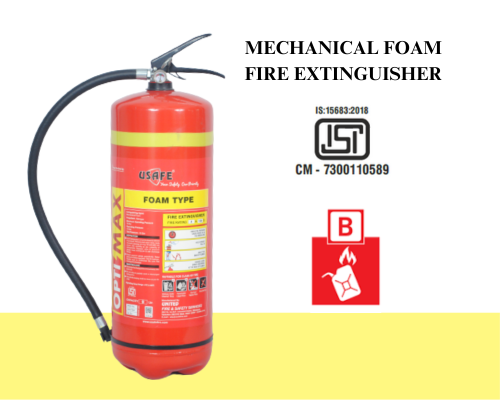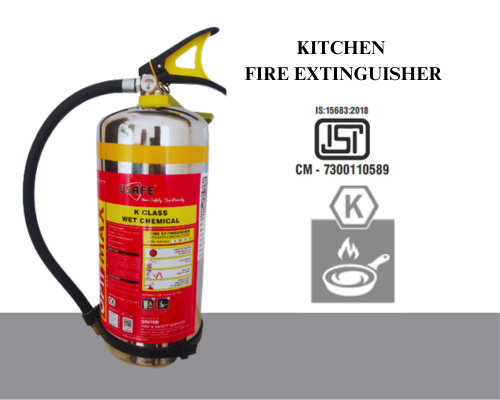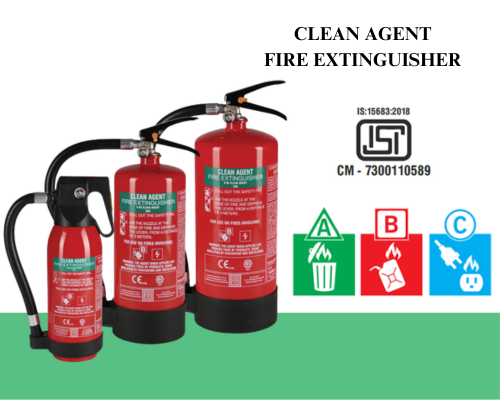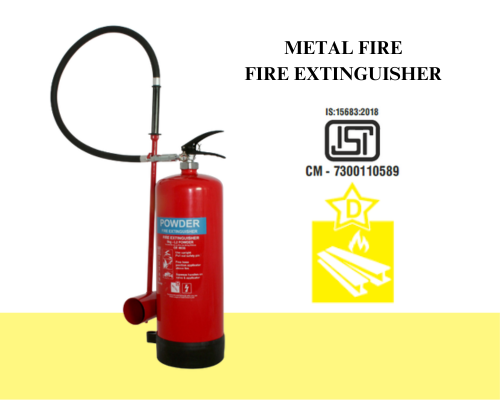
Fire Extinguisher
United Fire and Safety Services is a manufacturer and exporters of USAFE brand quality fire extinguishers which performs best to combat fires. The various types of fire extinguisher put out fires started with different types of fuel – these are called ‘classes’ of fire. The fire risk from the different classes of fire in your workplace area will determine which fire extinguisher types you need.
When a fire emergency occurs, it is crucial equipment to put out early-stage flames and save lives.
In every setting, including the workplace, home, and automobile, a fire extinguisher is essential. In order to put out fire before a major fire event occurs, automatic modular extinguishers and fire extinguisher systems are crucial for server racks, data centres, and many large enterprises. Each Fire extinguisher is made to combat a distinct kind of fire.
These extinguishers come with some cool features:
- All-in-One Design: They’re like a one-stop-shop for putting out fires. Everything you need is packed into one easy-to-handle package.
- Versatile: You can use these extinguishers at home, in your office, or even in big factories. They’re super flexible.
- Easy to Use: You don’t need a degree in firefighting to operate these. They’re simple and straightforward.
USAFE types of Fire Extinguishers suitable for different classes of Fires:
1. ABC Fire Extinguishers:
Standard dry powder fire extinguishers are also called ‘ABC’ extinguishers because they tackle class A, B and C fires, however, they are not recommended for use on class-D Metal Fire as well as Class For Class K –Cooking oil Fires. ABC type of fire extinguisher is works on
Class A fires – combustible materials: caused by flammable solids, such as wood, paper, and fabric
Class B fires – flammable liquids: such as petrol, turpentine or paint
Class C fires – flammable gases: like hydrogen, butane or methane
Additionally it can be used in Fires involving live electrical equipment under class E. Although ‘Class E’ technically does not exist in an Indian standard IS-15683 as well as European norms, it is being used in NFPA standards.
2.BC Powder Fire Extinguishers:
BC type of fire extinguisher is suitable for
Class B fires – flammable liquids: such as petrol, turpentine or paint
Class C fires – flammable gases: like hydrogen, butane or methane
Additionally it can be used in Fires involving live electrical equipment under class E. Although ‘Class E’ technically does not exist in an Indian standard IS-15683 as well as European norms, it is being used in NFPA standards.
3. Water & Foam Fire Extinguishers :
These are like the firefighters for wood, paper, and cloth fires – the stuff you find in your house.
4. Carbon Dioxide(CO2) Based Fire Extinguishers :
These are for liquid and electrical fires. Think of them as the fire whisperers for these types.
5. Clean Agent Fire Extinguishers :
If you have fancy electronic gadgets, these are the protectors for you. They’re gentle but effective.
6. Metal Fire Extinguisher:
Metals-related fires fall under class D.
7. Kitchen Fire Extinguisher:
In Kitchen Cooking oil-related fires, such as those in deep-fat fryers, fall under class “K” or Class “F”
8. Automatic Modular Type Fire Extinguishers:
To choose the right one, think about these things:
- What Could Catch Fire: Figure out what you have that could start a fire. This helps you choose the right extinguisher.
- Size and Weight: Make sure the extinguisher is a good fit for the people who’ll use it. You don’t want it too heavy or too small.
- Where to Put Them: Put them where fires are more likely to happen. For example, in the kitchen or near electrical stuff.
- Check the Rules: Some places have rules about the kind of extinguisher you need. Make sure you follow those rules.
Now, like anything, these extinguishers need a bit of care:
- Look at Them: Regularly check your extinguisher for damage, rust, or anything strange.
- Pressure Check: The pressure gauge should be in the right range. If it’s not, something’s up.
- Get Them Checked: Every now and then, get a professional to look at your extinguisher. They’ll keep it in top shape.
United Fire and Safety is the buddy you want for all your fire protection needs:
- Top-Quality Stuff: Our extinguishers meet all the highest safety standards.
- We Know Our Stuff: Our team knows these extinguishers inside and out. They’ll help you pick the perfect one.
- We Do It All: We can install them for you and make sure they’re always ready to save the day.
- We’re There in Emergencies: If a fire happens, we’re just a call away to help you out.
So, in a nutshell, Fire Extinguishers are like your trusty sidekicks for fighting fires. United Fire and Safety is here to make sure you’ve got the best one for your needs. When you choose us, you’re taking a big step in keeping your place safe and sound. Count on us, and we’ll be your partners in fire safety!
Frequently Asked Questions
What is the best type of fire extinguisher for my home?
Picking a fire extinguisher for your home is like choosing the right tool for a job. You’ve got different types because fires are kind of picky – they don’t all behave the same way.
First up, there’s Class A fires, the regular stuff like wood and paper. For these, go for a water or foam extinguisher. It’s like giving the fire a shower to cool it down.
Then, there’s Class B fires with flammable liquids like oil or gasoline. You’ll need a foam, dry chemical, or carbon dioxide (CO2) extinguisher. These guys are like the superheroes that tackle liquid fires.
Next, Class C is for electrical fires, like when your gadgets misbehave. Use a dry chemical or CO2 extinguisher, but never water – we don’t want sparks to fly, literally.
If you’ve got metals causing trouble (Class D fires), there are special dry powder extinguishers for that. Imagine it as sprinkling magic powder on metal fires to calm them down.
And for those kitchen mishaps with oils and fats (Class K fires), get a kitchen fire extinguisher with a wet chemical agent. It’s like having a kitchen superhero to handle those sizzling situations.
How do I use a fire extinguisher safely?
If you see a small fire and you have a fire extinguisher:
Grab and Aim:
Pull the pin, aim at the base of the fire.
Squeeze and Sweep:
Squeeze the handle, sweep side to side until the fire is out.
Step Back:
Stay about 6-8 feet away.
Watch Out:
Keep an eye in case the fire comes back.
Escape if Needed:
If the fire is big or not going out, get out and call for help.
Remember, these are for small fires – big ones need the experts. Stay safe!
What types of fires can each type of fire extinguisher extinguish?
Fire extinguishers are like superhero helpers for different kinds of fires:
1. Water Hero: Stops fires from wood and paper.
2. Foam Friend: Tackles liquid and gas fires.
3. Dry Powder Dynamo: Fights all kinds of fires – normal stuff, liquids, and electronics.
4. CO2 Crusader: Takes air away from liquid and electrical fires.
5. Dry Chemical Defender: Magic powder warrior against regular, liquid, and electrical fires.
6. Wet Chemical Wizard: Specialized in kitchen fires with oils and fats.
Pick the right superhero for the fire job, and stay safe!
